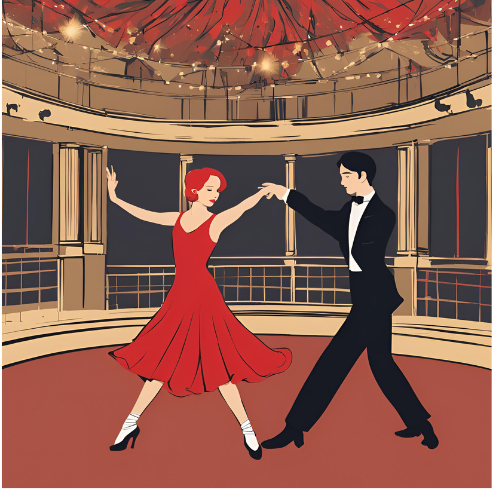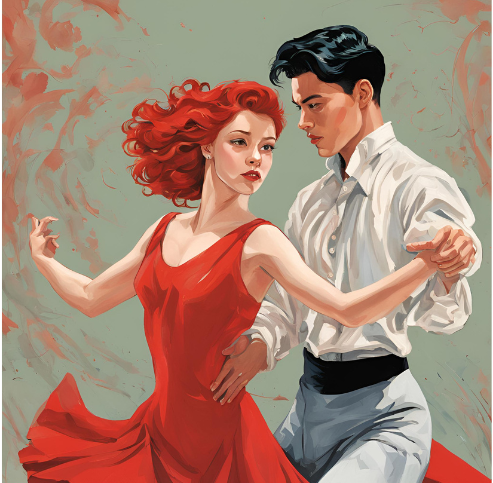Article Structure
- Introduction to Welcome to the Ballroom
- Provide an overview of the anime, including its release date, production studio, and the central premise. Highlight how the series introduces viewers to the intense and elegant world of competitive ballroom dancing, setting it apart from other sports anime.
- Character Development and Rivalries
- Discuss the growth and development of the main characters, particularly Tatara Fujita, Shizuku Hanaoka, and Kiyoharu Hyoudou. Explore the rivalries and relationships that drive the narrative, and how these dynamics contribute to their evolution as dancers.
- Key Story Arcs and Dance Competitions
- Outline the major story arcs, focusing on Tatara’s journey from a novice to a competitive dancer. Discuss significant dance competitions and how these events challenge the characters both physically and emotionally, pushing them to their limits.
- Stunning Animation and Choreography
- Highlight the animation quality, focusing on how the series visually captures the grace and intensity of ballroom dancing. Discuss the choreography, attention to detail, and how the animation brings the dance sequences to life, making them a visual spectacle.
- Impact on the Sports Anime Genre and Fan Reception
- Analyze the influence of "Welcome to the Ballroom" on the sports anime genre, particularly how it brings a lesser-known sport to the forefront. Discuss fan reception, critical acclaim, and the series’ role in popularizing competitive dance in anime.
Contents
Introduction to Welcome to the Ballroom
"Welcome to the Ballroom" is a captivating anime series that brings the intense and elegant world of competitive ballroom dancing to life. Released in July 2017, the anime was produced by Production I.G, a studio renowned for its high-quality animation and dedication to visually stunning storytelling. The series quickly garnered attention for its unique focus on ballroom dance, a sport not commonly explored in anime, setting it apart from other sports-themed series.
The story centers around Tatara Fujita, a typical high school student with no clear direction in life until a chance encounter introduces him to the world of ballroom dancing. Drawn to the grace and intensity of the sport, Tatara decides to pursue competitive dance, a journey that challenges him physically, mentally, and emotionally. The series follows his transformation from an unconfident beginner to a passionate dancer, driven by the desire to improve and find his place in this demanding world.
What makes "Welcome to the Ballroom" particularly engaging is how it immerses viewers in the high-stakes environment of ballroom dance competitions. The anime vividly portrays the elegance, discipline, and athleticism required to excel in the sport. Unlike traditional sports anime that focus on more widely recognized activities like soccer or basketball, "Welcome to the Ballroom" introduces a fresh perspective by highlighting a less conventional but equally compelling competitive field.
The animation plays a crucial role in bringing the dance sequences to life. Production I.G's expertise shines through in the fluid and dynamic movements that capture the rhythm and emotion of each performance. The character designs, particularly the elongated limbs and expressive faces, emphasize the grace and intensity of the dancers, making the competitions feel as dramatic and impactful as any high-octane sports event.
Beyond the technical aspects, "Welcome to the Ballroom" delves deep into the personal struggles and growth of its characters. Tatara’s journey is not just about mastering dance moves but also about discovering his passion and identity. His relationships with other dancers, such as the talented Shizuku Hanaoka and the ambitious Kiyoharu Hyoudou, add layers of complexity to the narrative, showcasing the rivalries and camaraderie that drive the world of competitive ballroom dancing.
In essence, "Welcome to the Ballroom" stands out in the sports anime genre for its unique subject matter and its ability to blend intense competition with personal growth and emotional depth. The series offers a refreshing take on sports anime, introducing viewers to a world where elegance and athleticism collide, all while telling a story that is both inspiring and relatable. Whether you're a fan of sports anime or new to the genre, "Welcome to the Ballroom" is a must-watch for its compelling characters, stunning animation, and the exciting world it brings to the screen.
Character Development and Rivalries

In "Welcome to the Ballroom," character development and the intense rivalries between dancers are central to the narrative, driving both the plot and the emotional depth of the series. The anime does more than just showcase the physical demands of competitive ballroom dancing; it delves into the personal growth of its characters, particularly Tatara Fujita, Shizuku Hanaoka, and Kiyoharu Hyoudou, as they navigate their relationships and the pressures of the dance floor.
Tatara Fujita, the protagonist, starts his journey as a directionless high school student, lacking confidence and purpose. His introduction to ballroom dancing ignites a passion within him that he never knew existed. Throughout the series, Tatara’s development is marked by his relentless determination to improve, not just as a dancer but as an individual. His growth is fueled by the relationships and rivalries he forms with other characters, each pushing him to confront his own limitations and rise to new challenges. Tatara’s evolution is both inspiring and relatable, as he struggles with self-doubt, the fear of failure, and the intense desire to prove himself in the competitive world of ballroom dancing.
Shizuku Hanaoka, one of the most talented dancers in the series, serves as both a mentor and a rival to Tatara. Shizuku’s character is defined by her dedication and discipline, traits that have made her a formidable competitor. However, her relationship with Tatara is complex; while she recognizes his potential, she is also keenly aware of the gap in their abilities. This dynamic creates a subtle tension between them, as Tatara strives to reach her level while Shizuku grapples with her own aspirations and the expectations placed upon her. Shizuku’s interactions with Tatara are pivotal to his growth, as she challenges him to push beyond his limits while also dealing with her own personal journey.
Kiyoharu Hyoudou is another key figure in the series, representing the pinnacle of what Tatara aspires to become. Kiyoharu is a prodigious dancer with a natural talent that sets him apart from his peers. His rivalry with Tatara is not one of animosity but rather one of inspiration and motivation. Kiyoharu’s presence in Tatara’s life forces him to confront the reality of his own abilities and the hard work required to succeed in the world of competitive dance. Despite his aloof exterior, Kiyoharu’s respect for Tatara’s determination becomes evident as the series progresses, highlighting the theme of mutual growth through competition.
The relationships between these characters are not only about rivalry; they are also about mutual respect, mentorship, and the shared pursuit of excellence. The dynamic between Tatara, Shizuku, and Kiyoharu creates a rich tapestry of interactions that drive the narrative forward. As Tatara grows more confident in his abilities, the lines between rivalry and camaraderie blur, leading to moments of both intense competition and deep personal connection.
The rivalries in "Welcome to the Ballroom" are not limited to mere competition on the dance floor; they are integral to the characters’ evolution. These rivalries push each character to confront their insecurities, embrace their strengths, and ultimately become better dancers and individuals. The series expertly balances these elements, creating a story that is as much about personal growth as it is about the art of dance.
In conclusion, the character development and rivalries in "Welcome to the Ballroom" are key to the series’ emotional depth and narrative complexity. Through the growth of Tatara, Shizuku, and Kiyoharu, the anime explores the challenges and triumphs of pursuing one’s passion in a competitive environment. These dynamics not only shape the characters’ journeys but also resonate with viewers, making "Welcome to the Ballroom" a compelling and memorable experience.
Key Story Arcs and Dance Competitions

In "Welcome to the Ballroom," Tatara Fujita’s journey from a complete novice to a competitive dancer is marked by several key story arcs that highlight his growth and the challenges he faces. These arcs are defined by the intense dance competitions that not only test Tatara’s physical abilities but also push him and his fellow dancers to their emotional limits.
One of the earliest and most significant story arcs is Tatara’s Introduction to Ballroom Dancing. Initially, Tatara stumbles into the world of ballroom dance by accident, but it quickly becomes his passion. This arc sets the foundation for the series, showcasing Tatara’s initial struggles to learn the basics of dancing and his determination to improve. Guided by his mentor, Sengoku, and inspired by the talents of Shizuku Hanaoka and Kiyoharu Hyoudou, Tatara begins to understand the discipline, grace, and athleticism required to succeed in competitive dance. His transformation from a shy, unconfident boy into someone who finds purpose on the dance floor is both inspiring and relatable.
As Tatara gains more experience, the series introduces the Tenpei Cup Arc, one of the first major competitions he participates in. The Tenpei Cup is a turning point for Tatara, as it’s his first real taste of competitive ballroom dancing. The pressure of performing on such a stage is immense, and the competition reveals the emotional toll that dancing can take on an individual. Tatara’s partnership with Shizuku during this competition also highlights the importance of trust and synchronization between partners, as they navigate the challenges of working together under intense scrutiny. The Tenpei Cup pushes Tatara to his limits, forcing him to confront his fears and insecurities while striving to prove himself in a world where he is still a newcomer.
Another critical arc in the series is the Metropolitan Tournament Arc, where Tatara partners with Chinatsu Hiyama, a fiery and headstrong dancer with a style completely different from his previous partners. This arc delves into the complexities of forming a new partnership, particularly when the dancers have conflicting personalities and approaches to the sport. The Metropolitan Tournament is a grueling event that tests not only the dancers’ technical skills but also their ability to work together harmoniously. Tatara’s relationship with Chinatsu is both challenging and transformative, as they learn to balance each other’s strengths and weaknesses. The tension and drama of this arc are heightened by the high stakes of the tournament, making it one of the most emotionally charged parts of the series.
The Grand Prix Arc is another pivotal storyline, representing the culmination of Tatara’s hard work and growth as a dancer. In this arc, Tatara competes against some of the best dancers in the country, including his rivals and friends. The Grand Prix is not just about winning; it’s about proving to himself and others how far he has come. The intensity of the competition, the high level of skill required, and the emotional weight of the event make this arc one of the most compelling in the series. The Grand Prix challenges Tatara in every way possible, pushing him to refine his technique, strengthen his mental resolve, and embrace the passion that drives him to dance.
Throughout these story arcs, "Welcome to the Ballroom" masterfully portrays the highs and lows of competitive ballroom dancing. Each competition serves as a milestone in Tatara’s journey, testing his physical endurance, emotional resilience, and commitment to the sport. The series captures the beauty and intensity of dance, while also exploring the personal growth that comes with pursuing a passion. The dance competitions are not just about winning trophies; they are about self-discovery, overcoming obstacles, and forging connections with others who share the same love for the art.
In conclusion, the key story arcs and dance competitions in "Welcome to the Ballroom" are integral to the narrative, driving both the plot and character development. Through Tatara’s journey, the series highlights the challenges and rewards of competitive dance, making it a compelling watch for fans of sports anime and those new to the genre alike.
Stunning Animation and Choreography

One of the standout features of "Welcome to the Ballroom" is its stunning animation, which brilliantly captures the grace, intensity, and emotion of competitive ballroom dancing. Produced by Production I.G, a studio renowned for its high-quality animation, the series is a visual spectacle that brings the art of dance to life in a way that few other anime have achieved.
The animation quality in "Welcome to the Ballroom" is exceptional, particularly in the way it portrays the fluidity and elegance of ballroom dancing. The characters’ movements are depicted with a level of detail and precision that mirrors the real-life demands of the sport. Each dance sequence is choreographed with meticulous attention to detail, from the intricate footwork to the sweeping motions of the dancers’ arms. The animators have gone to great lengths to ensure that every movement feels authentic, conveying the physicality and rhythm of ballroom dancing in a visually compelling manner.
What truly sets the animation apart is its ability to convey the emotional intensity of the characters as they perform. The series uses dynamic camera angles, slow-motion shots, and close-ups to highlight the dancers’ expressions and the nuances of their movements. These techniques not only showcase the technical skill of the dancers but also immerse the audience in the emotional highs and lows of each performance. Whether it’s the joy of a perfectly executed move or the tension of a competitive face-off, the animation captures the full spectrum of emotions that define the world of ballroom dancing.
The choreography in "Welcome to the Ballroom" is another key element that contributes to the series’ visual appeal. The dance routines are carefully designed to reflect the personalities and dynamics of the characters involved. For example, Tatara’s early dance sequences are characterized by a sense of hesitancy and inexperience, while his later performances exude confidence and grace as he grows more skilled. Similarly, the choreography for characters like Shizuku Hanaoka and Kiyoharu Hyoudou emphasizes their precision and control, showcasing their status as top dancers in the competitive circuit.
Each dance sequence is more than just a display of technical prowess; it is a narrative tool that advances the story and deepens the viewer’s understanding of the characters. The way the dancers interact with each other on the floor—through subtle glances, synchronized movements, or the tension of a close competition—adds layers of meaning to the narrative. The choreography effectively conveys the stakes of each competition, making the dance sequences not only visually stunning but also emotionally resonant.
Production I.G’s use of vibrant colors and lighting further enhances the visual experience. The ballroom scenes are often bathed in warm, golden hues that reflect the elegance and glamour of the sport. The use of light and shadow during performances adds depth and dimension to the animation, making the dancers appear even more lifelike. The character designs, with their elongated limbs and expressive faces, are perfectly suited to the fluidity and drama of ballroom dancing, allowing the animation to emphasize the grace and intensity of the performances.
In conclusion, the stunning animation and choreography in "Welcome to the Ballroom" are central to the series’ appeal. The visual portrayal of dance in the anime goes beyond mere representation; it captures the essence of ballroom dancing in all its beauty, intensity, and emotional depth. Through meticulous attention to detail and a deep understanding of the art form, the series brings the world of competitive ballroom dance to life, making it a must-watch for fans of both anime and dance.
Impact on the Sports Anime Genre and Fan Reception

"Welcome to the Ballroom" has made a significant impact on the sports anime genre by bringing the lesser-known world of competitive ballroom dancing into the spotlight. While sports anime traditionally focus on more mainstream activities such as basketball, soccer, or martial arts, this series offers a fresh perspective by delving into the elegance and intensity of ballroom dance. Its unique subject matter has not only expanded the horizons of what sports anime can explore but has also introduced audiences to a sport that many may have overlooked.
One of the most notable contributions of "Welcome to the Ballroom" to the genre is its ability to blend the physicality and competition typical of sports anime with the grace and artistry of dance. The series portrays ballroom dancing as a sport that requires not only physical strength and endurance but also precision, emotion, and creativity. By doing so, it challenges the conventional definition of sports anime, proving that the genre can encompass a wide range of activities, including those that are as much about art as they are about athleticism.
The fan reception of "Welcome to the Ballroom" has been overwhelmingly positive, particularly among viewers who appreciate its unique take on the genre. Fans have praised the series for its compelling character development, stunning animation, and the way it captures the intricacies of ballroom dance. The intense rivalries, emotional growth, and the personal struggles of the characters resonate deeply with audiences, making the series not only entertaining but also emotionally impactful.
Critically, "Welcome to the Ballroom" has received acclaim for its high-quality animation and attention to detail, particularly in its portrayal of dance sequences. The choreography, which accurately reflects the movements and techniques of real ballroom dancing, has been lauded for its authenticity and visual appeal. Critics have also noted the series’ ability to convey the tension and excitement of dance competitions, making them as thrilling as any sports event depicted in anime.
Moreover, "Welcome to the Ballroom" has played a crucial role in popularizing competitive dance within the anime community. Before the series aired, ballroom dancing was not a common theme in anime, and its inclusion in a sports anime was seen as a bold and innovative choice. The success of the series has opened the door for other anime to explore less conventional sports and activities, encouraging a more diverse range of stories within the genre.
The series’ role in popularizing ballroom dancing extends beyond just the anime itself. It has sparked interest in the sport among viewers, many of whom have expressed newfound appreciation for the complexity and beauty of ballroom dance. This increased visibility has also led to greater recognition of ballroom dancing as a legitimate and challenging sport, both within and outside the anime community.
In conclusion, "Welcome to the Ballroom" has had a profound impact on the sports anime genre, expanding its boundaries by introducing a lesser-known sport to a broad audience. Its unique blend of competition, artistry, and emotional storytelling has resonated with fans and critics alike, earning it a special place in the world of anime. The series has not only brought attention to the world of competitive ballroom dancing but has also demonstrated the genre’s potential to explore a wide variety of sports and activities. Through its success, "Welcome to the Ballroom" has paved the way for more diverse and innovative sports anime in the future.




